老挝电力发展规划-现状
浅析老挝输变电工程成本控制
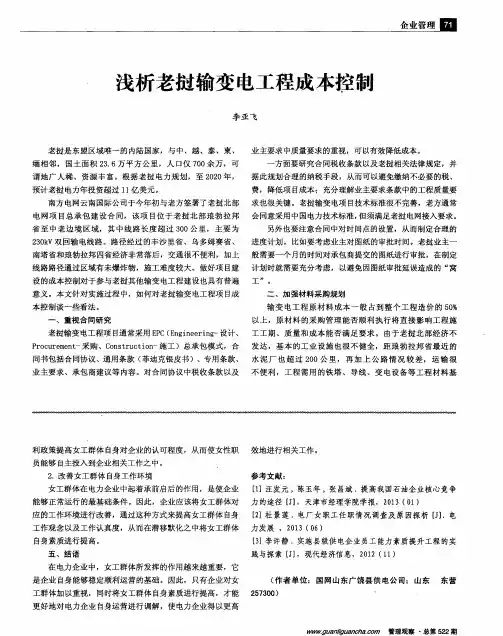
工群体加以重视 ,同时将女工群体 自身素质进行提高,才能 2 5 7 3 0 0)
企业 管理
本依 赖 从 中 国进 口。对 于 供 货 计 划 和 供货 方 式 的选 择 ,应 大 降低 业主 违 约 的 风 险 。 该充 分 考 虑 确 定 的施 工 计 划 以及 可行 性 研 究 调 查 的 市场 情 况 ; 同 时也 要 根据 预期 项 目收 款 情 况和 汇 率 变 化 形 势制 定
设计 是龙头 ,本 项 目管理 团 队在项 目初 期就 介入 ,初 设 变 更条款 向业 主提 出合 理索 赔要求 ,常 常对 于项 目增 收具有
阶段 ,线 路长度 就优 化 了 5公里 ,经 济效 益 明显 。
明显作用 。此 外 ,对于 多 以公开招 标进 行 的亚行 、世行 援助
、
重视 合 同研 究
老挝 输变 电工程 项 目通 常采用 E P C( E n g i n e e r i n g - 设计 、 工 工期、质量和成本能否满足要求。 由于老挝北部经济不 P r o c u r e m e n t 一 采 购 、C o n s t r u c t i o n 一 施 工 )总 承包 模 式 ,合 发 达 ,基 本 的工 业 设施 也很 不 健 全 , 距 琅 勃拉 邦 省 最 近 的 同书 包 括合 同协 议 、通用 条款 ( 菲 迪克 银皮 书 )、专用 条款 、 水 泥 厂也超 过 2 0 0公里 ,再 加上 公路 情况较 差,运输 很 业主 要 求 、承包 商建 议等 内容 。对 合 同协 议 中税 收条款 以及 不便利 ,工程需用的铁 塔、导线、变电设备等工程材料基
企 业管 理
浅析老挝输变电工程成本控制
李亚 飞
老 挝 是 东盟 区域 唯 一的 内陆 国家 , 与 中、越 、泰 、柬 、 缅相 邻 , 国土 面 积 2 3 . 6 万 平 方 公 里 ,人 口仅 7 0 0 余 万 ,可 谓 地 广 人稀 、资 源丰 富 。根据 老 挝 电力 规 划 ,至 2 0 2 0 年,
海外电力市场发展现状和前景
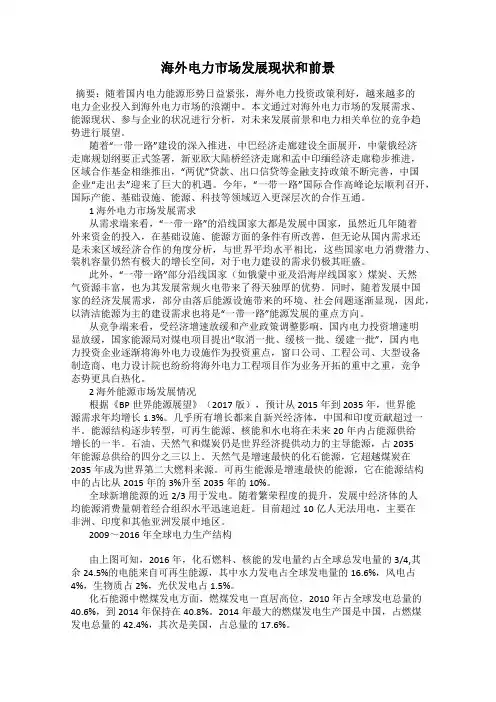
海外电力市场发展现状和前景摘要:随着国内电力能源形势日益紧张,海外电力投资政策利好,越来越多的电力企业投入到海外电力市场的浪潮中。
本文通过对海外电力市场的发展需求、能源现状、参与企业的状况进行分析,对未来发展前景和电力相关单位的竞争趋势进行展望。
随着“一带一路”建设的深入推进,中巴经济走廊建设全面展开,中蒙俄经济走廊规划纲要正式签署,新亚欧大陆桥经济走廊和孟中印缅经济走廊稳步推进,区域合作基金相继推出,“两优”贷款、出口信贷等金融支持政策不断完善,中国企业“走出去”迎来了巨大的机遇。
今年,“一带一路”国际合作高峰论坛顺利召开,国际产能、基础设施、能源、科技等领域迈入更深层次的合作互通。
1 海外电力市场发展需求从需求端来看,“一带一路”的沿线国家大都是发展中国家,虽然近几年随着外来资金的投入,在基础设施、能源方面的条件有所改善,但无论从国内需求还是未来区域经济合作的角度分析,与世界平均水平相比,这些国家电力消费潜力、装机容量仍然有极大的增长空间,对于电力建设的需求仍极其旺盛。
此外,“一带一路”部分沿线国家(如俄蒙中亚及沿海岸线国家)煤炭、天然气资源丰富,也为其发展常规火电带来了得天独厚的优势。
同时,随着发展中国家的经济发展需求,部分由落后能源设施带来的环境、社会问题逐渐显现,因此,以清洁能源为主的建设需求也将是“一带一路”能源发展的重点方向。
从竞争端来看,受经济增速放缓和产业政策调整影响,国内电力投资增速明显放缓,国家能源局对煤电项目提出“取消一批、缓核一批、缓建一批”,国内电力投资企业逐渐将海外电力设施作为投资重点,窗口公司、工程公司、大型设备制造商、电力设计院也纷纷将海外电力工程项目作为业务开拓的重中之重,竞争态势更具白热化。
2 海外能源市场发展情况根据《BP世界能源展望》(2017版),预计从2015年到2035年,世界能源需求年均增长1.3%。
几乎所有增长都来自新兴经济体,中国和印度贡献超过一半。
老挝发展现状
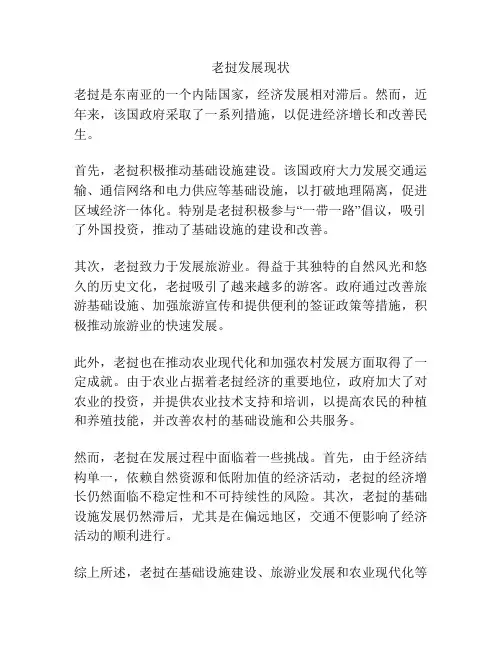
老挝发展现状
老挝是东南亚的一个内陆国家,经济发展相对滞后。
然而,近年来,该国政府采取了一系列措施,以促进经济增长和改善民生。
首先,老挝积极推动基础设施建设。
该国政府大力发展交通运输、通信网络和电力供应等基础设施,以打破地理隔离,促进区域经济一体化。
特别是老挝积极参与“一带一路”倡议,吸引了外国投资,推动了基础设施的建设和改善。
其次,老挝致力于发展旅游业。
得益于其独特的自然风光和悠久的历史文化,老挝吸引了越来越多的游客。
政府通过改善旅游基础设施、加强旅游宣传和提供便利的签证政策等措施,积极推动旅游业的快速发展。
此外,老挝也在推动农业现代化和加强农村发展方面取得了一定成就。
由于农业占据着老挝经济的重要地位,政府加大了对农业的投资,并提供农业技术支持和培训,以提高农民的种植和养殖技能,并改善农村的基础设施和公共服务。
然而,老挝在发展过程中面临着一些挑战。
首先,由于经济结构单一,依赖自然资源和低附加值的经济活动,老挝的经济增长仍然面临不稳定性和不可持续性的风险。
其次,老挝的基础设施发展仍然滞后,尤其是在偏远地区,交通不便影响了经济活动的顺利进行。
综上所述,老挝在基础设施建设、旅游业发展和农业现代化等
方面取得了一些进展,在推动经济增长和改善民生方面取得了一定成就。
然而,仍然需要解决一些挑战,以实现可持续的经济发展。
老挝电力市场
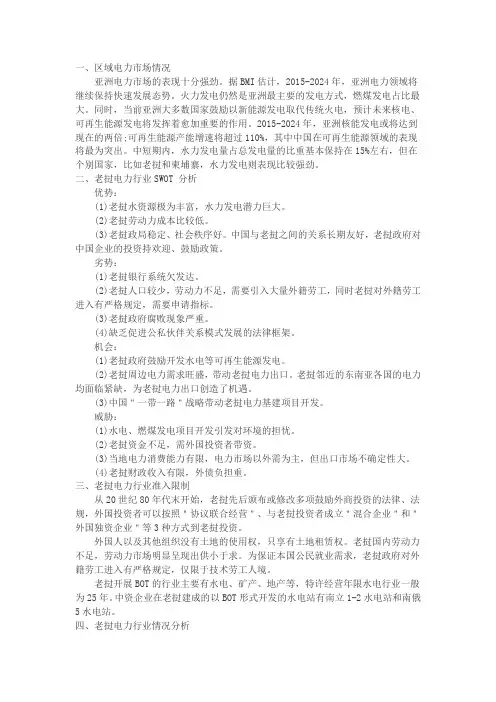
一、区域电力市场情况亚洲电力市场的表现十分强劲。
据BMI估计,2015-2024年,亚洲电力领域将继续保持快速发展态势。
火力发电仍然是亚洲最主要的发电方式,燃煤发电占比最大。
同时,当前亚洲大多数国家鼓励以新能源发电取代传统火电,预计未来核电、可再生能源发电将发挥着愈加重要的作用。
2015-2024年,亚洲核能发电或将达到现在的两倍;可再生能源产能增速将超过110%,其中中国在可再生能源领域的表现将最为突出。
中短期内,水力发电量占总发电量的比重基本保持在15%左右,但在个别国家,比如老挝和柬埔寨,水力发电则表现比较强劲。
二、老挝电力行业SWOT 分析优势:(1)老挝水资源极为丰富,水力发电潜力巨大。
(2)老挝劳动力成本比较低。
(3)老挝政局稳定、社会秩序好。
中国与老挝之间的关系长期友好,老挝政府对中国企业的投资持欢迎、鼓励政策。
劣势:(1)老挝银行系统欠发达。
(2)老挝人口较少,劳动力不足,需要引入大量外籍劳工,同时老挝对外籍劳工进入有严格规定,需要申请指标。
(3)老挝政府腐败现象严重。
(4)缺乏促进公私伙伴关系模式发展的法律框架。
机会:(1)老挝政府鼓励开发水电等可再生能源发电。
(2)老挝周边电力需求旺盛,带动老挝电力出口。
老挝邻近的东南亚各国的电力均面临紧缺,为老挝电力出口创造了机遇。
(3)中国"一带一路"战略带动老挝电力基建项目开发。
威胁:(1)水电、燃煤发电项目开发引发对环境的担忧。
(2)老挝资金不足,需外国投资者带资。
(3)当地电力消费能力有限,电力市场以外需为主,但出口市场不确定性大。
(4)老挝财政收入有限,外债负担重。
三、老挝电力行业准入限制从20世纪80年代末开始,老挝先后颁布或修改多项鼓励外商投资的法律、法规,外国投资者可以按照"协议联合经营"、与老挝投资者成立"混合企业"和"外国独资企业"等3种方式到老挝投资。
外国人以及其他组织没有土地的使用权,只享有土地租赁权。
老挝国内劳动力不足,劳动力市场明显呈现出供小于求。
老挝万象桑通光伏项目电力消纳分析
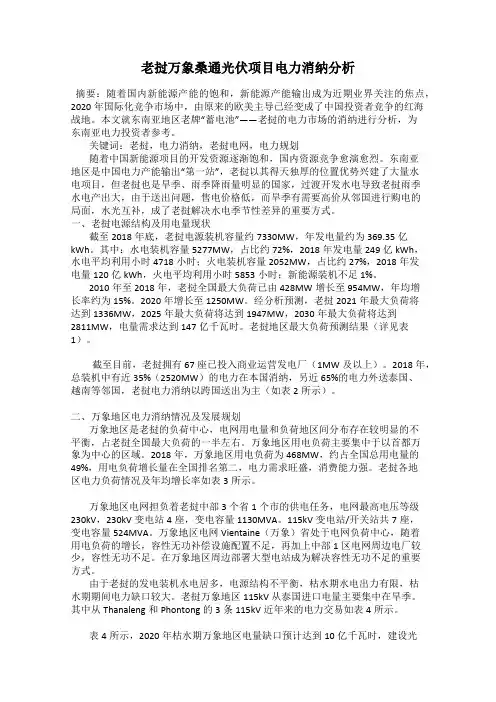
老挝万象桑通光伏项目电力消纳分析摘要:随着国内新能源产能的饱和,新能源产能输出成为近期业界关注的焦点,2020年国际化竞争市场中,由原来的欧美主导已经变成了中国投资者竞争的红海战地。
本文就东南亚地区老牌“蓄电池”——老挝的电力市场的消纳进行分析,为东南亚电力投资者参考。
关键词:老挝,电力消纳,老挝电网,电力规划随着中国新能源项目的开发资源逐渐饱和,国内资源竞争愈演愈烈。
东南亚地区是中国电力产能输出“第一站”,老挝以其得天独厚的位置优势兴建了大量水电项目,但老挝也是旱季、雨季降雨量明显的国家,过渡开发水电导致老挝雨季水电产出大,由于送出问题,售电价格低,而旱季有需要高价从邻国进行购电的局面,水光互补,成了老挝解决水电季节性差异的重要方式。
一、老挝电源结构及用电量现状截至2018年底,老挝电源装机容量约7330MW,年发电量约为369.35亿kWh。
其中:水电装机容量5277MW,占比约72%,2018年发电量249亿kWh,水电平均利用小时4718小时;火电装机容量2052MW,占比约27%,2018年发电量120亿kWh,火电平均利用小时5853小时;新能源装机不足1%。
2010年至2018年,老挝全国最大负荷已由428MW增长至954MW,年均增长率约为15%。
2020年增长至1250MW。
经分析预测,老挝2021年最大负荷将达到1336MW,2025年最大负荷将达到1947MW,2030年最大负荷将达到2811MW,电量需求达到147亿千瓦时。
老挝地区最大负荷预测结果(详见表1)。
截至目前,老挝拥有67座已投入商业运营发电厂(1MW及以上)。
2018年,总装机中有近35%(2520MW)的电力在本国消纳,另近65%的电力外送泰国、越南等邻国,老挝电力消纳以跨国送出为主(如表2所示)。
二、万象地区电力消纳情况及发展规划万象地区是老挝的负荷中心,电网用电量和负荷地区间分布存在较明显的不平衡,占老挝全国最大负荷的一半左右。
老挝电力规划可行性

降低电力成本
通过提高电力供应能力和优化电 力结构,降低老挝的电力成本, 促进经济发展和居民生活水平的
提高。
02 电力需求分析与 预测
老挝经济发展趋势
老挝经济增长
近年来,老挝经济呈现稳 步增长趋势,预计未来几 年将持续保持增长态势。
产业结构调整
老挝政府正致力于调整产 业结构,发展工业、农业 和服务业,这将对电力需 求产生影响。
电力结构单一
老挝电力结构以水电为主 ,缺乏其他可再生能源和 化石能源的补充,导致电 力供应稳定性差。
电力成本高
老挝电力成本较高,限制 了经济发展和居民生活水 平的提高。
规划建设必要性
经济发展需求
随着老挝经济的快速发展,电力 需求将持续增长,规划建设新的
电力项目是必要的。
能源安全保障
规划建设新的电力项目,尤其是可 再生能源项目,有助于降低对进口 能源的依赖,提高能源安全保障能 力。
提高居民生活水平和质量
改善供电状况
电力规划项目的实施将提高当地供电可靠性和稳定性,减少停电现象,满足居民 和企业用电需求,提高生活质量。
促进经济发展
稳定的电力供应将促进当地经济发展,提高居民收入水平,从而改善居民生活条 件和生活质量。
节能减排和生态环境保护贡献
降低碳排放
电力规划项目采用清洁能源发电,如水电、风电等,将降低 碳排放量,对全球气候变化和生态环境保护做出积极贡献。
老挝电力规划可行性
汇报人: 日期:
目录
• 项目背景与意义 • 电力需求分析与预测 • 电源结构与布局优化方案 • 输配电网络规划设计方案 • 投资估算与经济效益评价 • 社会效益及环境影响评价
01 项目背景与意义
老挝电力现状
老挝水电开发的成效以及影响
105第2卷 第34期老挝水电开发的成效以及影响谢 辉(中国水利水电第八工程局有限公司,湖南 长沙 410005)摘要:任何国家的发展都离不开水电开发事业的支持。
可以说,水电开发是促进国家经济社会发展的重要战略和手段。
20世纪80年代以来,老挝政府制定了若干促进水电开发事业发展的政策,希望可以发展水电站、完善国内电力系统,为国家持续发展提供更加有效的助力。
鉴于此,文章从老挝水电站的开发情况入手,阐述了其开发成效,并详细探讨了水电开发对其的积极影响和不利影响,以供相关研究参考。
关键词:老挝;水电开发;开发成效中图分类号:TV742 文献标识码:A 文章编号:2096-6164(2020)34-0105-02和老挝其他资源相比,老挝水资源更加丰富,为国家经济发展提供了重要的支撑,而水电开发事业势必会对周围水体造成影响,老挝临近湄公河,老挝国内的水电开发事业给湄公河水环境带来影响的可能性极大,这也正是老挝水电开发事业为何成为国际关注热点的原因之一。
1 老挝水电站开发情况老挝成立民主共和国,国家经济发展水平落后,人民生活贫困,导致老挝政府没有充足的资源和能力开展水电开发。
1981年,老挝经济发展进步,老挝政府开始对外开放,并且认识到国内水资源的优势,将水电方面的建设作为吸引外资的主要途径。
老挝南欧江流域一期水电站项目和老挝南欧江流域二期水电站项目相继在2012年、2016年动工,并在2016年、2021年完成。
1.1 老挝南欧江流域一期水电站项目建设项目(1)南欧江二级水电站。
该水电站位于老挝人民民主共和国中北部琅勃拉邦省境内,距中国昆明市公路里程919 km,该水电站属于二等大型工程,以发电为主,总库容1.217×108 m³。
(2)南欧江五级水电站。
位于老挝丰沙里省境内,距中国昆明市公路里程943 km,该水电站为二等工程,以发电为主,调节库容1.42×108 m3。
(3)南欧江六级电站。
老挝电力业的发展及相关法律制度探析
老挝电力业的发展及相关法律制度探析摘要:近年来,随着老挝政府不断强化革新开放政策,扩大对外合作,外资企业纷纷进入老挝寻找投资商机,其中水电资源开发已成为外国投资的重点领域之一。
开发电力资源既可以满足经济发展及人民生活对电力的需求,同时,电力开发的本身也能增加投资,为经济增长做贡献,并与老挝政府实施的“以资源换现金”的战略相吻合,因而得到高度重视,使老挝的电力业在近年发展迅速,值得关注。
老挝国会于1997年制定的《电力法》依然是目前调整电力投资、贸易的最高规范性法律文件,鉴于我国是老挝最大的外国电力投资者的现实,我们有必要对老挝的电力发展及其法律制度做深入研究,以便有利于我国企业在老挝的电力投资取得更好效果。
关键词:老挝;电力发展;法律制度一、老挝近年来电力业的发展近年来,随着老挝政府不断强化革新开放政策,扩大对外合作,外资企业纷纷进入老挝寻找投资商机,其中水电资源开发已成为外国投资的重点领域之一。
经电力勘察设计部门勘查,老挝境内水电资源理论蕴藏总量约为3000万千瓦,技术可开发总量为2347万千瓦,其中湄公河干流1225万千瓦(国际界河按1/2分摊水资源)约占全国技术可开发量的522%,湄公河支流及其他支流1122万千瓦,约占全国技术可开发量的473%。
老挝政府高度重视本国水电资源开发和利用,提出要将老挝建成“中南半岛蓄电池”的目标,为摆脱国家贫困和逐步实现工业化和现代化提供战略依托。
在第六个五年经济社会发展计划(2006—2010年)期间,老挝政府大力招商引资开发本国水电资源,将境内50多个5万千瓦装机容量以上可开发水电站项目悉数批给国内外公司,但截至目前大部分项目还未进入实际开发阶段。
据老方统计,已投入运营的水电站有12座,总装机容量187万千瓦,仅占全国技术可开发量的8%。
目前在建项目有7个,总装机容量282万千瓦;有15个项目已签署开发协议,装机容量5852万千瓦;有47个项目已签署合作备忘录,装机容量1270万千瓦。
老挝电力产业发展现状及前景
— ——从国外进口电力以满足边境地区、边远地区 和老挝国家电网尚未覆盖到的地区的用电需求。
5. 南林河第二水电站 (100 兆瓦,3.74 亿度),耗 资总额达 1.34 亿美元,由私人投资,工程预计在 2010 年完成。
争取在 2010 年前动工的有 9 个项目,发电总功 率达 863 兆瓦(MW),具体项目是:
1. 占巴色省色伽达电站(60 兆瓦,2.01 亿度),耗 资总额达 1.02 亿美元,尚未筹集到资金,工程计划在 2011 年竣工。
2001~2005 年期间,老挝完成了他纳一农黑高压 输电线工程、香恩—沙耶武里高压输电线路工程、南
勒—川圹高压输电线路工程、老挝中部—南部高压输 电线路工程、兹汕—空帕盆高压输电线路工程、班 纳—阿速波高压输电线路工程等多个电网工程的建 设。截至 2005 年年底,老挝全国的输电线路全长 19503.5 公里,其中,230 千伏(KV)的高压输电线路 246 公里;连接全国各省各县的 115 千伏(KV)的高压 输电线路长 1112.7 公里;中压输电线路长 8843.3 公 里,低压输电线路长 9 075 公里。为满足工业生产和 人们日常生活的需要,高压、中压和低压电网都得到 了广泛的发展,尤其是在人口密集地区得到了优先发 展。此外,老挝还在边远地区和乡村发展小型水电站、 太阳能电站等,对于尚没有建成永久性电网的边境县 份则从国外进口电力以满足生产和生活需要。
东南亚纵横 AROUND SOUTHEAST ASIA
2009.7
老挝电力市场现状和趋势浅析
老挝电力市场概况一、老挝国家概况老挝人民民主共和国位于中南半岛,与中国云南相邻,与越南、柬埔寨、泰国、缅甸交界,是东南亚唯一的内陆国,国土面积23.68km2,首都为万象特区。
老挝实行社会主义制度,老挝人民革命党是老挝唯一政党。
2022年,老挝全国人口753万,国内生产总值157亿美元。
二、老挝电力资源禀赋1.水电老挝境内山川河流众多,水能资源丰富,并主要分布在湄公河干流及其支流上,湄公河是流经缅、老、泰、柬、越五国的国际河流,其上游为中国的澜沧江,流经老挝长度1865km,占总长度44%。
老挝政府预计全国水电开发潜力为26GW,目前已开发水电容量约10GW,预计到2025年将完成12GW水电开发,到2030将完成20GW水电开发。
2.煤电老挝的煤炭资源分布较广,在北部、中部及南部地区均有矿床分布,但煤品质不高,以褐煤为主,已开发一座1878MW煤电站,规划开发容量约4GW,但受限于目前的国际融资环境,煤电开发较难实现。
3.新能源老挝南部省份的西侧光照资源最好,年辐射量可达到1899kWh/m2以上,向东和向北逐次递减;老挝的优质风能资源主要分布在中南部省份的东侧高海拔地区,平均风速可达6m/s-7m/s。
老挝地广人稀,新能源禀赋具备开发的经济性,但目前开发应用较为有限,政府正在筹备相关法规和规划,民间资本也在积极布局。
4.其他老挝的石油和天然气资源未有探明可采储量,油气全部依靠进口。
地热方面,未有可经济开发的资源,有企业计划进行研究但尚未得出成果。
三、电力市场主要参与方1.政府主管部门老挝能矿部负责老挝电力政策、战略、法律法规、标准的制定、执行和监管。
2.老挝国家电力公司及相关企业老挝国家电力公司(EDL)是老挝能矿部直属的国有企业,负责统筹管理老挝全国发电、输电、配电及电力进出口,为老挝全国用户提供电力。
老挝国家发电公众公司(EDL-Gen)是由EDL控股的发电企业,是老挝证券交易所首家上市公司,EDL 投资的电站资产由EDL-Gen运营管理。
- 1、下载文档前请自行甄别文档内容的完整性,平台不提供额外的编辑、内容补充、找答案等附加服务。
- 2、"仅部分预览"的文档,不可在线预览部分如存在完整性等问题,可反馈申请退款(可完整预览的文档不适用该条件!)。
- 3、如文档侵犯您的权益,请联系客服反馈,我们会尽快为您处理(人工客服工作时间:9:00-18:30)。
Part IPresent StatusGeneration Facilities1.1 ExistingThe generation Source Development in Lao PDR has been continuously developed together with the increasing demand of electricity in the period 2005-2009, the total installed capacity as of December 2005 was 670.8 MW (excluding off-grid system), of which 308.7 MW is owned by EDL while 362.1 MW is owned by Independent Power Producers for exporting power to neighboring countries, IPP(e)1. The growth rate of the installed capacity in the period 2008-2009 was 172%. The historical trend of the installed capacity of Hydropower plants are shown in Figure 1.1-1 below.Figure 1.1-1: Historical trend of the installed capacity.At present, the existing transmission system in side the country was not yet linked together. The total installed capacity as of December 2009 was 1,826.8 MW, all from Hydropower plants. The dramatically increase with the capacity of 1,156 MW in 2009 mainly from Xeset 2 (76 MW) and Nam Theun 2 (1,080 MW) hydropower plants. Of which 20.9% of capacity is owned by EDL and 78.9% are IPP(e). The existing hydropower plants of EDL and IPP(e) are listed in the Table 1.1-1, Appendix 1 and Figure 1.1-2 below.1Theun Hinboun HPP (210MW) and Houay Ho HPP (152.1 MW) and Nam Theun 2 HPP (1080MW)Figure 1.1-2: The existing installed capacity of hydropower plants as of December 2009.Figure 1.1-3: The existing hydropower plants in Lao PDR.1.2 Transmission Line and Substation FacilitiesAt Present, the high voltage transmission system (115 kV) was already linked between Central andNorthern areas in 2009 while Central and Southern link is under construction and expected to becompleted during 2010-2011. Details of the existing transmission system in Lao PDR are shown inFigure 1.2-1, Appendix 1, and Figure 1.2-2 below.Nam Ngum 1 hydropower plantXeset 2 hydropower plant Xeset 1 hydropower plantFigure 1.2-3: The existing transmission system and substations in Lao PDR.1.2.1 Northern AreaThe existing 115kV transmission line in the Northern area is interconnected with China system by single circuit of 115kV transmission line from Namo substation, Oudomxay province (Lao PDR) – Meung La substation (China) in 2009, Refer to Power Purchase Agreement (PPA) signed between EDL and China, EDL was allowed to imports power at this point with maximum 30MW. The power distribution in this area is delivered through various 115/22kV substations such as: Luang Namtha 1, Oudomxai, Luang Prabang 1, Pakmong, Sayabuly and some parts is delivered through imports power from Provincial Electricity Authority of Thailand (PEA) via the 22kV distribution line. As of December 2009, the existing 115/22kV substations in this area consist of 6 locations with the total installed capacity of 107 MVA (as seen in the Table 1.2-1, Appendix 1). The total length of the 115kV transmission lines is totally 594.5 cct-km (as seen in Table 1.2-2, Appendix 1).1.2.2 Central AreaThe high voltage transmission systems in this area are connected with three (3) major hydropowerplants namely Nam Ngum 1 (155 MW), Nam Leuk (60 MW) and Nam Mang 3 (40 MW). These plants are supplied electric energy mainly to Central area and some parts of Northern area. The power distribution in the Vientiane Capital is delivered through various 115/22kV substations (Phonetong, Naxaythong, Tha Ngon, Khoksa ad, and Thanaleng), Vientiane province is deliveredthrough 115/22kV substations (Phonsoung, Thalat, Bandon, Nonhai, Nam Ngum1, Nam Leuk, Nam Mang 3 and Vangvieng), Bolikhamxai province is delivered through 115/22kV Pakxansubstation, and Xiengkhuang is delivered through 115/22kV Phonsavan substation. As ofSubstation Control Room 115kV Transmission LineDecember 2009 the 115/22kV substations in this area consist of 14 locations with the total installed capacity of 446.5 MVA (as seen in the Table 1.2-1, Appendix 1) and the total length of 115kV transmission line is totally 799.9 km, 898.6 cct-km (as seen in Table 1.2-2, Appendix 1).The 115kV transmission system in this area is also interconnected to EGAT’s system for the purposes of exchange power each other (import/export). There are two interconnection points namely: 1) from Phontong substation (Lao PDR) to Nongkai substation (EGAT, Thailand) by double (2) circuits of 115kV transmission lines and Single (1) circuit of 115kV transmission line from Thanaleng substation (Lao PDR) to Nongkai substation (EGAT, Thailand) and 2) from Pakxan substation (Lao PDR) to Bungkan substation (EGAT, Thailand) by Double (2) circuits (Strung one circuit) of 115kV transmission line. The details are shown in the Table 1.4-1, Appendix 1.1.2.3 Southern AreaThe 115 kV transmission systems in this area will be linked with Central system during 2010-2011, the project is under construction. The connection will start from Pakxan substation (Bolikhamxay province)-Thakhek (Khammouane province)-Pakbo substation (Savanakhet province) by double (2) circuits of 115kV transmission lines. Moreover, the Southern area system is also interconnected to EGAT’s system for the purpose of exchange power each other (import/export) namely: 1) Double circuit of 115kV transmission line from Thakhek substation (Lao PDR) to Nakhonphanom substation (EGAT, Thailand), 2) Double circuit (Strung one circuit) of 115kV transmission line from Pakbo substation (Lao PDR) to Mukdahan substation (EGAT, Thailand), and 3) Single circuit of 115kV transmission line from Bangyo substation (Lao PDR) to Sirinthon hydropower plant (EGAT, Thailand).Besides the interconnection with EGAT’s system, the 115 kV transmission line in Khammouane province was also expanded to supply power to the large consumers such as: from Thakhek substation – Sepon (mine) substation, from Thakhek – Cement Factory (Mahaxay) and from Nam Theun 2 (75MW) – Mahaxay substation.Power supply to the urban, districts and rural area of Saravan, Sekong, Attapeu and Champasak provinces come from three (3) major hydropower plants namely: 1) Xeset 1 (45MW), 2) Xeset 2 (76MW) and 3) Selabam (5MW). Currently, the 115/22kV substations in this area encompass 10 locations with the total installed capacity of 359 MVA (as seen in the Table 1.2-1, Appendix 1).The total length of 115kV transmission lines is totally 666.5 km, 989.6 cct-km (as seen in Table 1.2-2, Appendix 1). The power distribution in this area is delivered through various substation such as: Khammouan province is delivered through 115/22kV substations (Thakhek and Mahaxai), Savanakhet province is delivered through 115/22kV substations (Pakbo and Kengkok), Saravan province is delivered through 115/22kV Xeset 1 power stations, Champasack province is delivered through 115/22kV substations (Bangyo, Jiengxai, Pakxong, Ban Na and Ban Hat) and Attapeu province is delivered through 115/22kV Saphaothong substation.1.3 Distribution FacilitiesCurrently, EDL’s medium voltage (MV) distribution system is principally of 12.7kV, 22kV, 25kV, 34.5kV and 35kV. Those medium voltage Feeders are extended to urban and rural areas from 115/34.5/22kV substations. The low voltage (LV) distribution systems are generally of 400/220V, 3 phase and 4 wires.SFigure 1.3-1: The existing medium and low voltage systems.Refer to the statistics of medium voltage network since 2003 up to 2009, the growth rate was in the range of 6-15% (as seen in Table 1.3-1, Appendix 1) and shown in Figure 1.3-2 below.Medium Voltage Distribution SystemMedium Voltage Distribution System -Low Voltage System Medium Voltage Distribution System Medium Voltage Distribution System -Medium Voltage Distribution SystemFigure 1.3-2: Historical trend of medium voltage system.Refer to the statistics of low voltage network since 2003 up to 2009, the growth rate was in the range of 4-12% (as seen in Table 1.3-1, Appendix 1) and shown in Figure 1.3-3 below.Figure 1.3-3: Historical trend of low voltage system.The growth rate of installed capacity of distribution transformers in horizon 2003-2009 was in the range of 9-15% (as seen in Table 1.3-2, Appendix 1) and shown in Figure 1.3-4 below.Figure 1.3-4: Historical trend of installed capacity of distribution transformers.1.4 International Connecting LinesBesides, 115 kV interconnection lines with neighboring countries as mentioned-above, EDL’s distribution system (22kV, 35kV) was also interconnected with neighboring countries too for the purpose of supply power to the bordering areas and to the place where is no network existed. Details of international connecting lines are as follows:#International Connecting lines with PEA: Muong Houayxay (Bokeo province), Muong Khop, Muong Ngeun, Muong Xienghon, and Muong Kenthao (Xayabuly province).#International Connecting lines with Electricity of Vietnam (EVN): Muong Sopbao (Huaphanh province), Dansavan (Savannakhet province), Muong Samouay (Saravan province), Muong Dakcheung (Sekong province) and Danphoukeua (Attapeu province).#International Connecting lines with Electricite Du Combodge (EDC): Ban Hat Substattion (Lao PDR) to Stung Treng substation (Cambodia).#International Connecting lines with China Southern Grid (CSG): Muong Sing and Botendenkham (Luang Namtha province).Details of the existing interconnecting lines with neighboring countries Including IPP(e)’s lines as of December 2009 are summarized in Table 1.4-1, Appendix 1.1.5 Past Energy Consumption RecordHistorical trend of energy consumption of each area in horizon 2001-2009 are tabulated in Table 1.5-1, Appendix 1, and shown in Figure 1.5-1 below.Figure 1.5-1: Historical trend of energy consumption.Remark:−The data in horizon 2005-2009 was including Sepon Gold/Copper mine and Mahaxay Cement Factory consumption.Figure 1.5-1 above and Table 1.5-1, Appendix 1 are indicated that the growth rate of energy demand for whole country in horizon 2001-2009 was continuously increased with an average growth rate was 4% (2002-2003), while big growth was in period 2005-2006 with 39% (Data 2005 is including of Sepon Gold/Copper mine and Mahaxay Cement factory demand), an average growth rate of energy demand in Northern, Central and Southern areas were 24.3%, 12.2% and 19.7% respectively. The average growth rate of energy demand for whole country was 15.2%, the main reason is that electricity requirement from the rural electrification expansion projects, industrial, Commercial loads.1.6 Past Peak Load RecordThe past peak load record of each area in period 2001-2009 are listed in Table 1.5-1, Appendix 1, and shown in Figure 1.6-1 below.Figure 1.6-1: Historical trend of peak loadRemark:−The data in horizon 2005-2009 was including Sepon Gold/Copper mine and Mahaxay Cement Factory consumption.Figure 1.6-1 above and Table 1.5-1, Appendix 1 are indicated that the growth rate of peak Load for whole country in horizon 2001-2009 was continuously increased with an average growth rate of 7% (2001 to 2002), while 23% was in period 2008-2009. An average growth rate of peak Load in Northern, Central and Southern areas were 24.9%, 14.2% and 9.3% respectively. The average growth rate of peak load for whole country was 13.3%, the main reason please refer to the item 1.5.1.7 Energy Consumption by Consumer TypesThe past energy consumption by consumer type is shown in the Table 1.5-2, Appendix 1. The energy consumption by consumer type was classified into seven (7) categories: Industry, Agriculture, Enterprises, Entertainment, Government Office, Residential and Embassies. Share of the energy consumption of each category in the whole country is shown in the Table 1.7-1. In order to evaluate the Socio-Economic development in the country which related with to energy consumption, the energy consumption by consumer types were re-classified into four (4) categories: Residential, Industry, Agriculture and Service (Enterprises, Entertainment, Government Office, and Embassies). The details are shown in the Table 1.5-3, Appendix 1, and Figure 1.7-1 and 1.7-2 below.-100,000,000200,000,000300,000,000400,000,000500,000,000600,000,000700,000,000800,000,000900,000,000200120022003200420052006200720082009k W hResidential ServiceFigure 1.7-1: Historical trend of energy consumption by consumer types.Figure 1.7-1 indicated that the past energy consumption by consumer types in period 2001-2009 for whole country, the Residential and Agriculture categories were increased normally while Industrial and Service categories were dramatically increased in period 2006-2009 (for Industrial category) and 2007-2009 (for Service category) and the growth rate of these categories will continuously increase. With the increasing of energy consumption for these categories, it can be explained that the social economic development in the country is being improved.Figure 1.7-2: Share of energy consumption by consumer types.Figure 1.7-2 is indicated that the share of energy consumption by consumer types in period 2001-2009 for the whole country. The share of the Residential and Agriculture categories were decreased while share of the Industry and Service categories were continuously increased. That means the country is going toward the industrialized country step by step.The numbers of customers by category for whole country are shown in the Table 1.7-1 and numbers of customers by Residential and non-residential categories are shown in the Table 1.7-2, Appendix 1.100,000200,000300,000400,000500,000600,000700,000800,000200120022003200420052006200720082009Figure 1.7-3: Total number of consumers by Residential and non-Residential categories.Figure 1.7-3 indicated that the total numbers of consumers by Residential and Non-Residential categories have been increased year by year to fulfill the government target on the rural electrification and socio-economic development plans.1.8 Gross Power Generation and Power Export/ImportThe gross power generation, power export/import of the country during 2001-2009 is tabulated in Table 1.8-1. The average growth rate of generation, import and export in the period 2001-2009 were 1-27%, 3-61% and 3-51% respectively. Almost 100% of total energy is generated by hydropower plants namely: Nam Ngum 1 (155MW), Nam Mang 3 (40MW), Nam Leuk (60MW), Xeset 1 (45MW), Xeset 2 (76MW), small hydropower plants and other sources. The details are shown in Table 1.8-1, Appendix 1.2004006008001,0001,2001,4001,6001,8002,000200120022003200420052006200720082009G W h /Y e a rImport Export GenerationFigure 1.8-1: Production, Import and Export in the country.Figure 1.8-1 indicated that the average generation in period 2001-2009 was approximately 1,560 GWh p.a. while trend of Export energy was reduced and the Import energy from neighboring countries was increased 182 GWh (2001), 819 GWh (2009). That means the demand of electricity in the country is high requirement while supply requirement was imbalance.。
